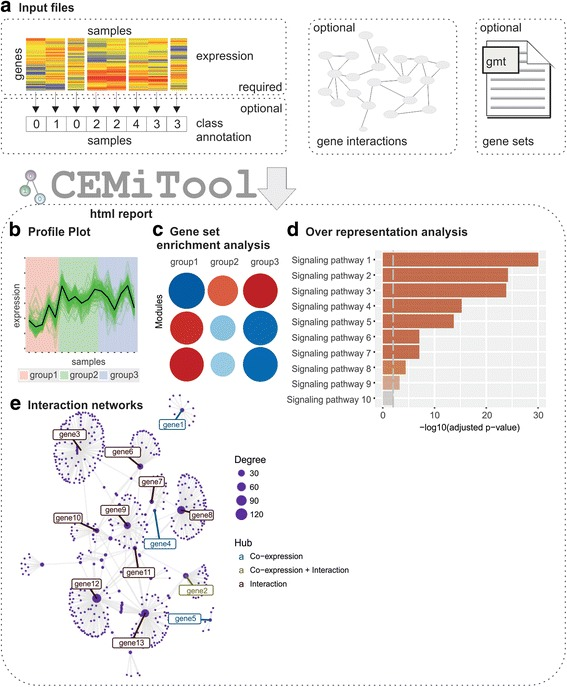CEMiTool: a Bioconductor package for performing comprehensive modular co-expression analyses.
The analysis of modular gene co-expression networks is a well-established method commonly used for discovering the systems-level functionality of genes. In addition, these studies provide a basis for the discovery of clinically relevant molecular pathways underlying different diseases and conditions. In this paper, we present a fast and easy-to-use Bioconductor package named CEMiTool that unifies the discovery and the analysis of co-expression modules. Using the same real datasets, we demonstrate that CEMiTool outperforms existing tools, and provides unique results in a user-friendly html report with high quality graphs. Among its features, our tool evaluates whether modules contain genes that are over-represented by specific pathways or that are altered in a specific sample group, as well as it integrates transcriptomic data with interactome information, identifying the potential hubs on each network. We successfully applied CEMiTool to over 1000 transcriptome datasets, and to a new RNA-seq dataset of patients infected with Leishmania, revealing novel insights of the disease's physiopathology. The CEMiTool R package provides users with an easy-to-use method to automatically implement gene co-expression network analyses, obtain key information about the discovered gene modules using additional downstream analyses and retrieve publication-ready results via a high-quality interactive report.
Authors
Pedro S T Russo; Gustavo R Ferreira; Lucas E Cardozo; Matheus C Bürger; Raul Arias-Carrasco; Sandra R Maruyama; Thiago D C Hirata; Diógenes S Lima; Fernando M Passos; Kiyoshi F Fukutani; Melissa Lever; João S Silva; Vinicius Maracaja-Coutinho; Helder I Nakaya
External link
Publication Year
Publication Journal
Associeted Project
User-friendly computational Tools
Lista de serviços
-
Genomic analyses reveal broad impact of miR-137 on genes associated with malignant transformation and neuronal differentiation in glioblastoma cells.Genomic analyses reveal broad impact of miR-137 on genes associated with malignant transformation and neuronal differentiation in glioblastoma cells.
-
RNA-Binding Protein Musashi1 Is a Central Regulator of Adhesion Pathways in Glioblastoma.RNA-Binding Protein Musashi1 Is a Central Regulator of Adhesion Pathways in Glioblastoma.
-
MicroRNA Transcriptome Profiling in Heart of Trypanosoma cruzi-Infected Mice: Parasitological and Cardiological Outcomes.MicroRNA Transcriptome Profiling in Heart of Trypanosoma cruzi-Infected Mice: Parasitological and Cardiological Outcomes.
-
Genome mapping and expression analyses of human intronic noncoding RNAs reveal tissue-specific patterns and enrichment in genes related to regulation of transcription.Genome mapping and expression analyses of human intronic noncoding RNAs reveal tissue-specific patterns and enrichment in genes related to regulation of transcription.
-
Antimicrobial peptide LL-37 participates in the transcriptional regulation of melanoma cells.Antimicrobial peptide LL-37 participates in the transcriptional regulation of melanoma cells.
-
Down-regulation of 14q32-encoded miRNAs and tumor suppressor role for miR-654-3p in papillary thyroid cancer.Down-regulation of 14q32-encoded miRNAs and tumor suppressor role for miR-654-3p in papillary thyroid cancer.
-
Integration of miRNA and gene expression profiles suggest a role for miRNAs in the pathobiological processes of acute Trypanosoma cruzi infection.Integration of miRNA and gene expression profiles suggest a role for miRNAs in the pathobiological processes of acute Trypanosoma cruzi infection.
-
Integrative Biology Approaches Applied to Human DiseasesIntegrative Biology Approaches Applied to Human Diseases
-
Proteomics reveals disturbances in the immune response and energy metabolism of monocytes from patients with septic shock.Proteomics reveals disturbances in the immune response and energy metabolism of monocytes from patients with septic shock.
-
Genomics, epigenomics and pharmacogenomics of Familial Hypercholesterolemia (FHBGEP): A study protocol.Genomics, epigenomics and pharmacogenomics of Familial Hypercholesterolemia (FHBGEP): A study protocol.
-
Melatonin-Index as a biomarker for predicting the distribution of presymptomatic and asymptomatic SARS-CoV-2 carriersMelatonin-Index as a biomarker for predicting the distribution of presymptomatic and asymptomatic SARS-CoV-2 carriers
-
Profiling plasma-extracellular vesicle proteins and microRNAs in diabetes onset in middle-aged male participants in the ELSA-Brasil study.Profiling plasma-extracellular vesicle proteins and microRNAs in diabetes onset in middle-aged male participants in the ELSA-Brasil study.
-
Big Data and machine learning in cancer theranosticsBig Data and machine learning in cancer theranostics
-
Genomic positional conservation identifies topological anchor point RNAs linked to developmental loci.Genomic positional conservation identifies topological anchor point RNAs linked to developmental loci.
-
Integrative systems immunology uncovers molecular networks of the cell cycle that stratify COVID-19 severityIntegrative systems immunology uncovers molecular networks of the cell cycle that stratify COVID-19 severity

